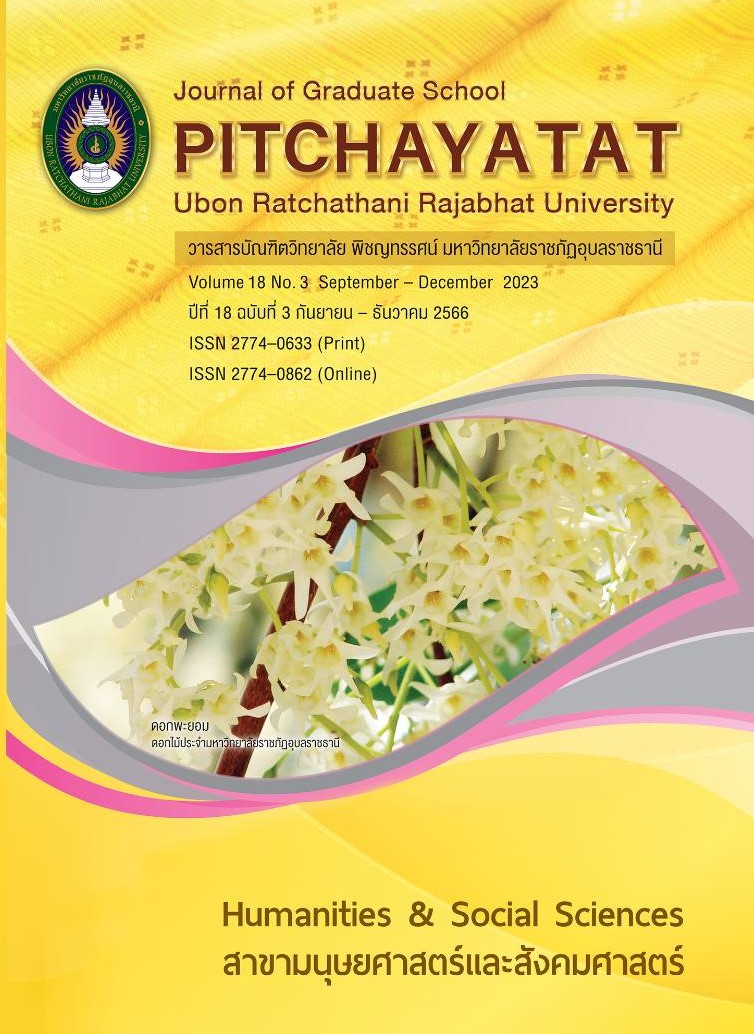การพัฒนาทักษะการอ่านจับใจความของนักเรียนชั้นมัธยมศึกษาปีที่ 3 โดยใช้การจัดการเรียนรู้ด้วยสื่อ Interactive Notebook
คำสำคัญ:
การอ่านจับใจความ , การจัดการเรียนรู้ด้วยสื่อ Interactive Notebookบทคัดย่อ
การวิจัยนี้มีวัตถุประสงค์เพื่อ 1) พัฒนาทักษะการอ่านจับใจความของนักเรียนเทียบกับเกณฑ์ร้อยละ 70 และ 2) เปรียบเทียบทักษะการอ่านจับใจความก่อนเรียนและหลังเรียนของนักเรียนชั้นมัธยมศึกษาปีที่ 3 โดยใช้การจัดการเรียนรู้ด้วยสื่อ Interactive Notebook ตัวอย่างที่ใช้ในการวิจัย คือ นักเรียนชั้นมัธยมศึกษาปีที่ 3/6
โรงเรียนเบ็ญจะมะมหาราช จำนวน 30 คน ซึ่งได้จากการสุ่มแบบกลุ่ม ด้วยวิธีการจับสลาก โดยใช้ห้องเรียนเป็นหน่วยสุ่ม เครื่องมือที่ใช้ ได้แก่ แผนการจัดการเรียนรู้ จำนวน 6 แผน และแบบทดสอบการอ่านจับใจความ สถิติที่ใช้ ได้แก่ ร้อยละ ค่าเฉลี่ย ส่วนเบี่ยงเบนมาตรฐาน และการทดสอบที
ผลการวิจัยพบว่า
1. ผลการพัฒนาทักษะการอ่านจับใจความของนักเรียนชั้นมัธยมศึกษาปีที่ 3 โดยใช้การจัดการเรียนรู้ด้วยสื่อ Interactive Notebook พบว่า นักเรียนผ่านเกณฑ์ร้อยละ 70 จำนวน 30 คน คิดเป็นร้อยละ 100 โดยคะแนนเฉลี่ยทั้งหมดคิดเป็น 82.27
2. ผลการเปรียบเทียบทักษะการอ่านจับใจความก่อนการจัดการเรียนรู้ และหลังการจัดการเรียนรู้
ของนักเรียนชั้นมัธยมศึกษาปีที่ 3 โดยใช้การจัดการเรียนรู้ด้วยสื่อ Interactive Notebook พบว่า หลังเรียนสูงกว่าก่อนเรียนอย่างมีนัยสำคัญทางสถิติที่ระดับ .05
เอกสารอ้างอิง
จุฬารัตน์ อินทร์อุดม. การพัฒนาความสามารถในการอ่านจับใจความสำคัญของนักเรียนชั้นมัธยมศึกษาปีที่ 1 โดยใช้เทคนิค SQ4R ร่วมกับพลังคำถาม. วิทยานิพนธ์ศึกษาศาสตรมหาบัณฑิต มหาวิทยาลัยศิลปากร, 2562.
ถวัลย์ มาศจรัส. นวัตกรรมการศึกษาชุด แบบฝึกหัด–แบบฝึกทักษะ เพื่อพัฒนาผู้เรียน และการจัดทำผลงานทางวิชาการอาจารย์ 3 และบุคลากรทางการศึกษา (ครูชำนาญการครูเชี่ยวชาญ และครูเชี่ยวชาญพิเศษ). กรุงเทพฯ: ธารอักษร, 2546.
ทดสอบทางการศึกษาแห่งชาติ, สถาบัน. รายงานผลการทดสอบทางการศึกษาระดับชาติขั้นพื้นฐาน (O-NET) ปีการศึกษา 2563. (ออนไลน์) 2563 (อ้างเมื่อ 22 มิถุนายน 2565). จากhttp://www.newonetresult.or.th/AnnouncemenWeb/Login.aspx
ทดสอบทางการศึกษาแห่งชาติ, สถาบัน. รายงานผลการทดสอบทางการศึกษาระดับชาติขั้นพื้นฐาน (O-NET) ปีการศึกษา 2564. (ออนไลน์) 2564 (อ้างเมื่อ 22 มิถุนายน 2565). จาก http://www.newonetresult.or.th/AnnouncemenWeb/Login.aspx
ทักษพร โพธิ์เหมือน. การพัฒนาการอ่านจับใจความโดยใช้ เทคนิค 4W1H ส่งเสริมทักษะการอ่านภาษาอังกฤษของนักเรียนชั้นประถมศึกษาปีที่ 3. วิทยานิพนธ์ศึกษาศาสตรมหาบัณฑิต มหาวิทยาลัยธุรกิจบัณฑิต, 2561.
นิภาพรรณ ทองสว่าง และอ้อมธจิต แป้นศรี. “การพัฒนาผลสัมฤทธิ์ทางการอ่านจับใจความสำคัญ ของนักเรียนชั้นมัธยมศึกษาปีที่ 1 โดยใช้แบบฝึกทักษะ ร่วมกับเทคนิค 9 คำถาม,” ปราชญ์ประชาคม. 7, 7 (เมษายน-สิงหาคม 2565): 1-16.
ผะอบ โปษะกฤษณะ. ลักษณะของภาษาไทย การเขียน การอ่าน การพูด การฟัง และราชาศัพท์. กรุงเทพฯ: รวมสาส์น, 2554.
พรทิพย์ ชาตะรัตน์. “การอ่าน: เครื่องมือในการแสวงหาความรู้,” ศิลปกรศึกษาศาสตร์วิจัย. 5, 1 (มกราคม 2545): 59
พรพรรณ พูลเขาล้าน. การพัฒนาความสามารถในการอ่านเพื่อความเข้าใจโดยใช้การจัดการเรียนรู้แบบ ActiveLearning ร่วมกับเทคนิค SQ4R. ปริญญานิพนธ์การศึกษามหาบัณฑิต มหาวิทยาลัยศรีนครินทรวิโรฒ, 2563.
พัฒนพงษ์ สีหานารินทร์. “การพัฒนาความสามารถในอ่านจับใจความสำคัญโดยการจัดการเรียนรู้แบบ SQ4R สำหรับนักเรียนชั้นมัธยมศึกษาปีที่ 2,” มจร อุบล ปริทรรศน์ 7, 2 (พฤษภาคม-สิงหาคม 2565): 2-10.
มลชญา หินศรีสุวรรณ. การพัฒนากรอ่านจับใจความสำคัญของนักเรียนชั้นประถมศึกษาปีที่ 6 โดยใช้ระเบียบวิธีแบบวิทยาศาสตร์. วิทยานิพนธ์ศึกษาศาสตรมหาบัณฑิต มหาวิทยาลัยเชียงใหม่, 2550.
ยุทธิชัย อุปการดี. “การพัฒนาความสามารถด้านการอ่านจับใจความตามรูปแบบSQ4R ร่วมกับเทคนิค 5W1H โดยใช้บทอ่านวรรณกรรมท้องถิ่นสำหรับนักเรียนชั้นมัธยมศึกษาปีที่ 2,” วารสารศึกษาศาสตร์ มหาวิทยาลัยทักษิณ. 5, 1 (กุมภาพันธ์-มีนาคม 2565):18-21.
วรวรรณ สุขสวัสดิ์. การพัฒนาความสามารถในการอ่านจับใจความภาษาอังกฤษโดยใช้ผังมโนทัศน์ของนักเรียนชั้นมัธยมศึกษาปีที่ 3. วิทยานิพนธ์ศึกษาศาสตรมหาบัณฑิต มหาวิทยาลัยธุรกิจบัณฑิต, 2561.
วัสมน กฤษกลาง. การศึกษาความสามารถในการอ่านจับใจความและทักษะการคิดวิเคราะห์ของนักเรียนชั้นมัธยมศึกษาปีที่ 3 โดยวิธีการสอนอ่าน แบบบูรณาการของ Murdoch (MIA) ร่วมกับแผนผังกราฟฟิก. วิทยานิพนธ์ครุศาสตรมหาบัณฑิต มหาวิทยาลัยราชภัฏนครราชสีมา, 2560.
วิมลรัตน์ สุนทรโรจน์. เอกสารประกอบการสอนวิชา 0506703 พัฒนาการเรียนการสอน. มหาสารคาม: มหาวิทยาลัยสารคาม, 2545.
ศึกษาธิการ, กระทรวง. หลักสูตรแกนกลางการศึกษาขั้นพื้นฐาน พุทธศักราช 2551. กรุงเทพฯ: กระทรวงศึกษาธิการ, 2551.
สิทธิพงศ์ สิริวราพงศ์. การพัฒนาชุดกิจกรรมการอ่านจับใจความวิชาภาษาไทยสำหรับ นักเรียนชั้นมัธยมศึกษาปีที่ 1 โรงเรียนบ้านไผ่โทน (นวลราษฎร์ วิทยา) อำเภอร้องกวาง จังหวัดแพร่. วิทยานิพนธ์ครุศาสตร มหาบัณฑิต มหาวิทยาลัยราชภัฏอุตรดิตถ์, 2550.
อรุณรัสมิ์ บำรุงจิตร. “สมุดงานแบบโต้ตอบ (Interactive Notebook) กับการพัฒนาการเรียนรู้ของผู้เรียน,” วารสารราชภัฏหมู่บ้านจอมบึง. 23, 4 (ตุลาคม-ธันวาคม 2563): 23-24.
อรุณรัสมิ์ บำรุงจิตร. “Interactive Notebooks: Students Innovation in the Integrated English Program (IEP) Mathematics Classroom,” วารสารครุศาสตร์ราชภัฏเลย. 10, 1 (มกราคม-มิถุนายน 2559): 26-32
Jaladanki and Bhattacharya. “Interactive Notebook: Arts-based Approach to Physics,” Instruction, Creative Approaches to Research. 8, 2 (January 2015): 32.
Horne. “Using Interactive Notebooks to Help ELL Students Find Confidence inwriting,” Language Arts Journal of Michigan. 36, 2 (February 2021): 5.
Waldman, C. and K. Crippen. “Integrating Interactive Notebooks: A Daily Learning Cycle to Empower Students for Science,” The Science Teacher. 76, 1 (January 2009): 5.
ดาวน์โหลด
เผยแพร่แล้ว
รูปแบบการอ้างอิง
ฉบับ
ประเภทบทความ
สัญญาอนุญาต
ลิขสิทธิ์ (c) 2023 วารสารบัณฑิตวิทยาลัย พิชญทรรศน์ มหาวิทยาลัยราชภัฏอุบลราชธานี

อนุญาตภายใต้เงื่อนไข Creative Commons Attribution-NonCommercial-NoDerivatives 4.0 International License.
บทความทุกเรื่องได้รับการตรวจความถูกต้องทางวิชาการโดยผู้ทรงคุณวุฒิภายนอกอย่างน้อย 3 คน ความคิดเห็นในวารสารพิชญทรรศน์เป็นความคิดเห็นของผู้นิพนธ์มิใช่ความคิดเห็นของผู้จัดทำ จึงมิใช่ความรับผิดชอบของวารสารพิชญทรรศน์ และบทความในวารสารพิชญทรรศน์สงวนสิทธิ์ตามกฎหมายไทย การจะนำไปเผยแพร่ต้องได้รับอนุญาตเป็นลายลักษณ์อักษรจากกองบรรณาธิการ





